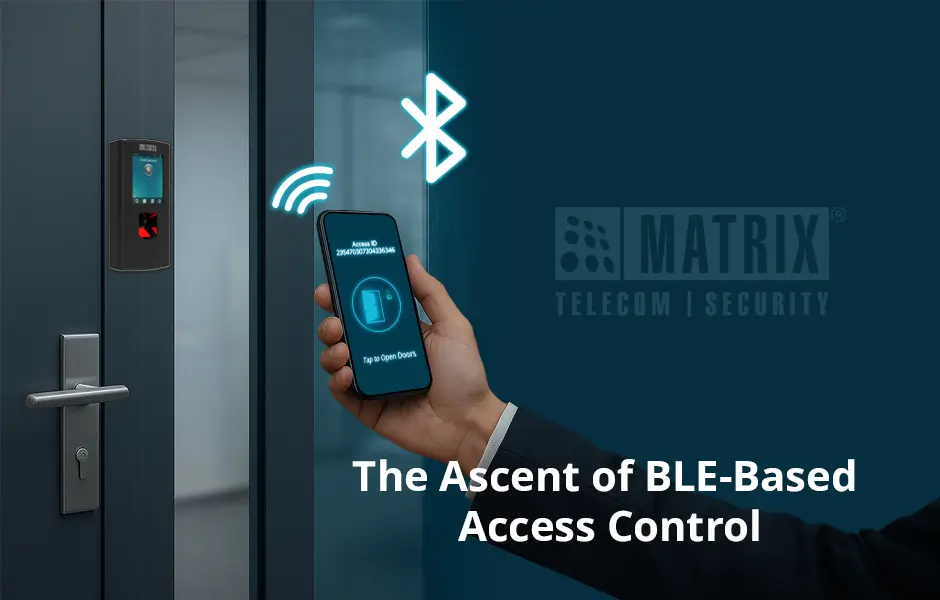
Smartphones are now an integral part of our daily lives. According to Press Information Bureau, Delhi, the number of active wireless (mobile) subscribers (on the date of peak Visitor Location Register) in May 2025 was 1080.06 million.
They influence everything from communication to complex calculations, and this pervasive integration extends to access control, where mobile technology is swiftly transforming traditional security measures.
The global mobile access control market, valued at USD 1.2 billion in 2023, is projected to reach USD 4.9 billion by 2032, demonstrating a robust CAGR of 16.9% from 2024 to 2032. This significant growth highlights the increasing adoption of mobile-first access solutions, particularly Bluetooth-based access control solutions. Electronic access control companies are actively promoting soft or virtual credentials via mobile phones, aiming to replace physical cards or touch-based biometrics with convenient alternatives like Face Recognition, QR codes, PINs, and particularly Bluetooth Low Energy (BLE).
This blog explores the transformative impact and myriad benefits of Bluetooth-based access control systems in modern security landscapes.
The Rise of Mobile-First Access: BLE-Based Solutions Transforming Security
The ubiquity of smartphones makes them an ideal electronic key in physical access control systems, offering a touchless and convenient credential. Bluetooth Low Energy (BLE) stands out as the preferred technology for developers due to its high performance and energy efficiency.
Bluetooth-based access control facilitates direct communication between a Bluetooth-enabled mobile phone and a door controller, managed by a dedicated mobile application or software. Each smartphone’s unique ID can function as a secure PIN or key for authentication, a process managed through “Profiling” software. Enrollment is a simple, one-time setup during the mobile application’s installation, with a web-based application then governing access to the Bluetooth device.
Key Advantages of Bluetooth-Based Access Control Systems:
Effortless Access
Users can gain access by simply gesturing with their smartphone within range of a Bluetooth-enabled door controller, saving time and simplifying entry. For instance, an employee can enter the office building by simply waving their phone near the door, eliminating the need to search for a badge.
Scalability
Unlike biometric solutions, there are no limitations on the number of users, making BLE systems highly flexible for organizations of all sizes. A large university campus can easily manage access for tens of thousands of students and staff without needing to reconfigure hardware for new enrollments.
Versatility
Bluetooth-based access control systems are particularly effective in environments where traditional biometric devices might be impractical or difficult to use. In a healthcare setting, medical professionals wearing gloves can easily access restricted areas without needing to remove them for a fingerprint scan.
Simplified Setup
Only a one-time Bluetooth pairing is required, streamlining the deployment process. Setting up a new user’s access involves a quick pairing process with their smartphone, rather than issuing and configuring a physical card.
Enhanced Security
Communication between the mobile device and the access control system is securely encrypted. Data transmitted between the smartphone and the door reader is protected against interception, ensuring credentials remain private and secure.
Unique Device Identification
The system leverages the mobile phone’s unique IMEI number for robust authentication. This provides an additional layer of security, as each phone has a distinct identifier linked to its authorized user.
Conclusion: Embracing the Future with BLE
The increasing prevalence of Bluetooth-enabled smartphones firmly establishes their role as a primary component in the future of physical access control systems. This technology delivers a secure, convenient, and highly scalable alternative to conventional access methods. As the demand for seamless and touchless access continues to grow, cutting-edge solutions like Matrix Bluetooth-based access controllers and readers are leading the way, providing advanced security that integrates effortlessly with contemporary lifestyles. Discover how Matrix’s innovative BLE solutions can elevate your access control infrastructure.

